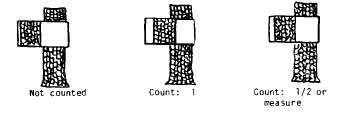User Tools
This is an old revision of the document!
Use of Wedge Prism
The prism is a piece of a wedge-shaped rectangular glass which causes a distortion of light, displacing the image towards the thinner edge. It is used to estimate the basal area of a stand.
Basal Area
1. Hold prism (not your eye) over the selected point at a comfortable distance from the eye, with the long side horizontal. Hold prism with right hand by lower part of the thicker edge. 2. With one eye closed, point with the upper part of the prism so as to divide the tree in question at breast height. Refraction of light through the prism will cause the portion of the tree below breast height to appear separated. Count as 1 all of the trees whose figures are superimposed, as 1/2, or measure for accuracy those which touch only at the edge. If they do not touch each other they are not counted.
3. Turn in a circle, checking each visible tree, making sure not to count the same tree twice. 4. The number of trees counted, multiplied by basal area conversion factor of prism gives us the basal area per stand acre. BA/Acre = (Total number of trees counted X BAF of prism)/(Number of samples)
Basal Area Factor. Set up a target exactly one foot wide. Fro an approximate 10 BAF prism,
sight about 33 feet from target. Move toward or away from target until right edge of target
(as seen in prism) jibes with the left edge of target (just above prism). Measure exact
distance prism to target. Take several readings and use average.
Calculate BAF by formula:
BAF = (43560)/[(1+4)(D/W)2]
D is distance prism to target
W is width of target
or: BAF = (43560)/[(1+4)(D)2]
Where target “W” is exactly 1 foot wide
or: BAF = 10890(W/D)2
A close approximation

